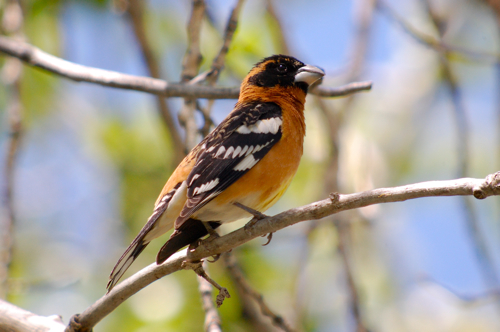
Golden Eagle vs Chukar
I can't believe I forgot about these photos. While cleaning out my iPhoto cache today I came across a picture of a chukar at Antelope Island in Utah.
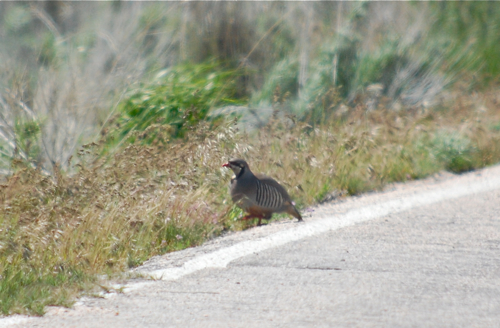
Okay, so it's a very mediocre photo of a chukar. I was driving around, just taking photos of anything when I tried to get a shot of this chukar. They are all over the island and I always end up seeing them on the sides of roads or in parking lots. They also have a knack for scurrying in to grass or brush as soon as a lens is aimed at them. Less than a minute after I got this photo, the chukar dove into the grass. I told myself to look up and about 10 feet above my rental car windshield was a golden eagle.
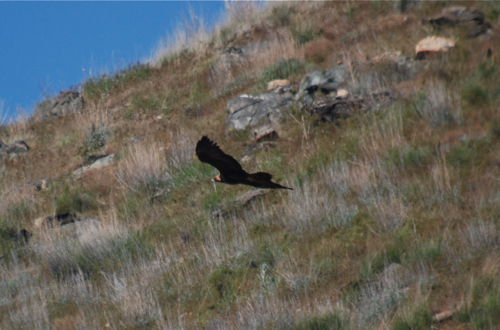
I wasn't able to get a camera on the golden until it was well past, it moving moving fast! Scott Mehus at The National Eagle center says that if you see turkeys running like a bat out of hell from a field near a goat prairie around Wabasha, MN, chances are good there's a gold eagle overhead. The golden made a dive for the chukar and missed it, but boy, what a treat to have right in front of the car.
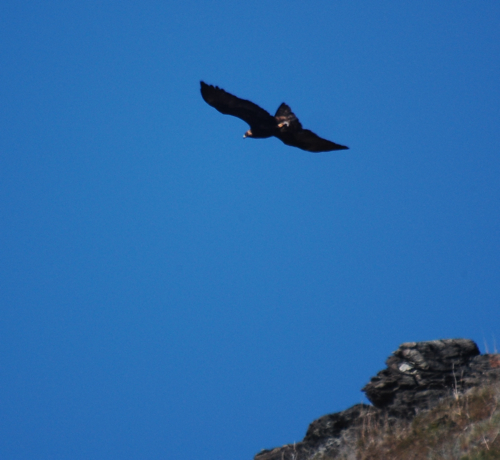
After that I got bonus time of watching the golden eagle circle on thermals coming off the bluffs on Antelope Island. It was great to be able to see the golden hackle feathers (the feathers on the back of the head).
Pelican Yawn
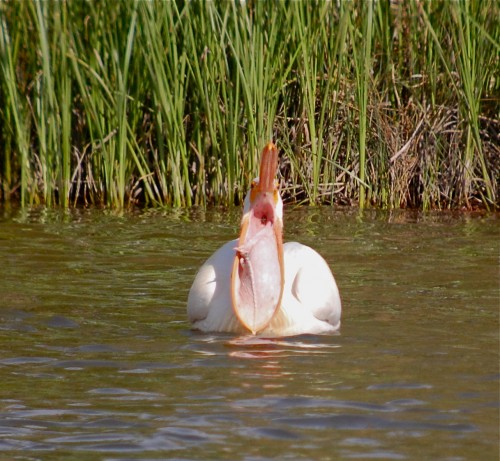 If you're a fish or crawfish, this is a terrifying site. Especially because American white pelicans will cooperatively hunt fish in the water.
If you're a fish or crawfish, this is a terrifying site. Especially because American white pelicans will cooperatively hunt fish in the water.
Bison & Lazuli Buntings
For some reason, buntings are a hard bird for me to get. Both painted buntings and lazuli buntings were always fluttering out of sight just before I would arrive to see one. A common phrase, "Oh a whole flock just flew past here like five minutes ago." I finally got painted a couple of years ago in Florida but the lazuli seemed intent on pouring salt on my wounds. When we went to Las Vegas to make bird videos, Non Birding Bill saw one and when he pointed it out, the lazuli bunting flew away and all I saw was a small bird flashing blue. Gr.

When I was at the Great Salt Lake Bird Festival this past spring, word on the street was that a flock of lazulis were hanging out at feeding station near the barn on Antelope Island State Park. I consulted Bill Thompson about this and he gave good directions. I had a tough time finding the exact location of the feeder, it was sort of hidden away in some trees. There was the above bison pen nearby but the beast was fenced up so I could keep my ungulate phobia in check. I was getting the old ungulate stare down though. That's right, bison, I'm just going about my birding business, you stay there.

The feeders were absolutely dead. There was a sprinkler nearby and some birds were using the water source. I decided to stake myself out among some bushes, set up my scope and camera and hope for the best. I figured that this would be another opportunity to NOT see a lazuli and concentrated on the few birds that did come in like the above white-crowned sparrow. Suddenly, a large flock of pine siskins descended on the feeder and I aimed my digiscoping set up on them. The feeder was in the shade and it wasn't easy to get photos, but digiscoping passed the time as I waited for a lazuli.

And then magically among the siskins was a lazuli bunting! As soon as I got this shot it took off. As it flew, I heard chip notes and then the same chip notes from other buntings in the trees above me. More were around and I'm sure this little migratory flock couldn't resist coming down to this food source. So I waited.

And in about 10 minutes, a flock of lazuli buntings were on the ground. It was a challenge getting any photos because the birds were in the shade and my camera didn't want to give me the shutter speed I needed. So I played around and used the timer.

And I did manage to get some fun shots. Note the tiny white millet seed on the tip of the beak of this male? Most birding feeding guides say to not use millet or at least not very much, but colorful buntings are one of the few species of birds that really, really like it and it's worth having a bit in your seed mixes during the spring and fall migration.

As I was living la vie da lazuli, I suddenly heard a heavy "thump, thump, thump" and it sounded like an ungulate in full trot mode right behind me. I turned around to the sound and discovered...

The bison that was in the first photo of this post was now very much out of the pen and trotting around behind me. It started trotting right at me, then turned and went the opposite direction. I tried to take a shot as it headed towards the left of the barn (you know, one of those last known photos they could find in my trampled camera next to my trampled body). The bison pretty much went in the direction I needed to go in order to get back to my car. I stayed where I was, heart pounding and recalled the video of the woman who got charged by a bison because her idiot brother-in-law threw a stick at it to get his attention. I wouldn't do anything like that, but what if I inadvertently startled it? I've said it before and I'll say it again--large ungulates make me nervous and I really don't think my Sand People technique of startling cows would work well with a bison. They are unpredictable and it's really just a matter of time until they realize how big they are and stampede the heck out of me. I went back into the trees to stay out of the bison's line of vision and debated with myself on how to get out with a rogue bison on the loose. I soon saw one of the Antelope Island rangers and went up to here, "Uh, your bison is on the loose!"
I was also going to ask for a ranger escort back to my car but she said, "Oh yeah, he's fine, it's feeding time."
I was not going to get a ranger escort back to my car. They have signs all over this island that read, "Stay away from bison" and so I found her mellow attitude about the loose animal unnerving but I also realized that I have a larger fear of bison than most and decided to man up and walk myself back to the car. I didn't encounter that particular animal...but...

...my bison encounter was not over. Bison roam this island and on the road back to the exit, a small herd was grazing along the side. I slowed and the bison decided to cross. I had to get a shot of how close this one was to the road--see the mirror of my rental car on the right hand side? I slowly drove past, the bison watched me and I assumed the sort of upright posture most drivers do when passing a police or sheriff's car that says, "No, sir, I'm not speeding, I'm a good citizen."
Small price to pay I guess for finally getting my lifer lazuli bunting.
Random Northern Harrier
Some forgotten photos from my May trip to Utah. This was a male northern harrier hunting around Antelope Island:

One of the few North American raptors you can tell the difference between male and female by color.


 He even got some prey!
He even got some prey!
 Harrier hunting grounds.
Harrier hunting grounds.
Artificial Heron Rookery
Not long after the North Mississipppi heron rookery was destroyed, there was talk of building an artificial rookery to get them to come back. Now that the herons seemed to have settled on other islands, the situation isn't as dire--they found plenty other nesting opportunities. However, if an area is missing good nesting sites for herons, it is possible to create it. Here's an example of one in Utah at Farmington Bay WMA in Utah (thanks to Facebook, I have to work really hard not to calling Farmville WMA):
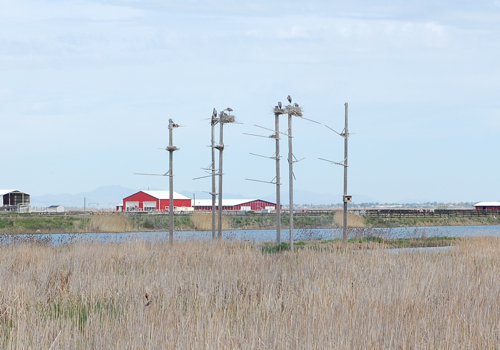
Heron nesting sites can disappear for a variety of reasons. Accumulation of heron fecal material can kill off vegetation or even the trees the birds use for nesting. I think the trees and vegetation on the river islands stay in tact because of annual flooding, the river rises and the waters swamp this island washing a lot of the collected poop away. But I've been to other areas that aren't prone to flooding and gradually, the vegetation dies. After several seasons, storms or general wear and tear can cause the dead trees to fall. Or maybe there aren't any trees there to begin with.
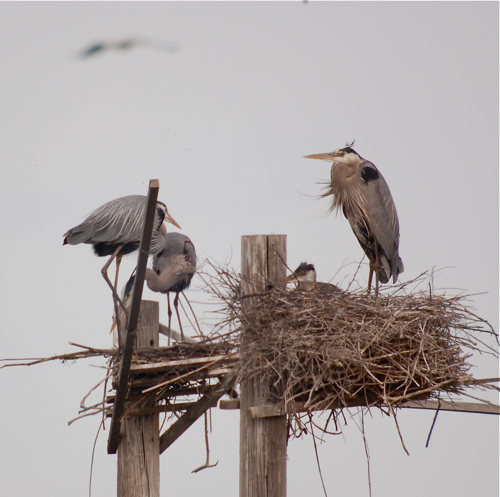
If nesting trees aren't available and the number of herons decreases then fake trees can be added. Woodworking for Wildlife offers plans and info on how to build them and I've been to at least 2 places (this year alone) where fake rookeries have been readily used by herons. Now, you can't just put up some poles at a pond and expect herons to use it. Before you put it up or before you put up any bird house habitat try to think about the species you are trying to attract. Herons usually forage less then four miles from their nest, so you need to make sure there are lots and lots food sources nearby. If the food isn't there it won't be successful. Kind of like putting up a bluebird box in the middle of the woods, that's not their habitat.
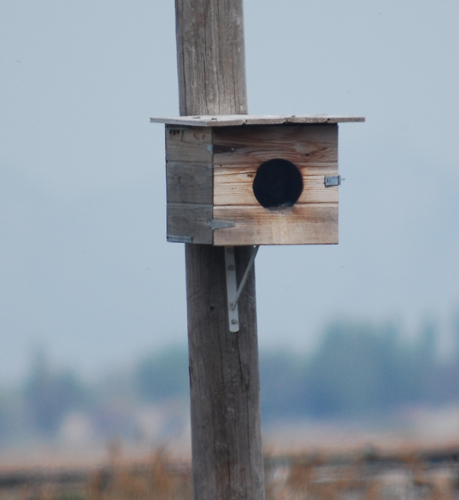
I was out with a digiscoping tour while visiting the artificial rookery and people in the group noted this box attached to one of the poles. At first, it threw me for a loop. I tried to think of all the bird boxes we carried at the bird store or that I'd seen around MN and couldn't figure it out. I noticed some movement, put the scope on it and discovered barn owls inside. No wonder, we don't have barn owls in Minnesota so I would be familiar with this sort of nesting box. Alas, I wasn't able to digiscope them but it was cool to see it in use. It makes sense, I've seen herons nest with red-tails and I'm sure a barn owl isn't much of a threat with their tiny feed.
Random Western Meadowlark

Random Coot
 I just thought this was a really cool digiscoped picture of a coots face. Normally when you see them out on a lake, you see a black duck with a white beak (yesssssssss, I know they aren't really a duck but most people describe them that way). Often, most don't see their eyes. Love this bright red eye.
I just thought this was a really cool digiscoped picture of a coots face. Normally when you see them out on a lake, you see a black duck with a white beak (yesssssssss, I know they aren't really a duck but most people describe them that way). Often, most don't see their eyes. Love this bright red eye.
Podcasting This Week
Just a quick heads up about the podcast this week. It looks like we'll only be able to record one and we will record it Tuesday night and it will be up Wednesday morning. I'm right in the middle of my crazy spring work schedule. As I type this, I'm in Utah and won't be home until tonight and Non Birding Bill also has a Theatre Arlo gig tonight. But we'll get one in before I head to Detroit Lakes on Thursday and this week it will be longer. In the meantime:
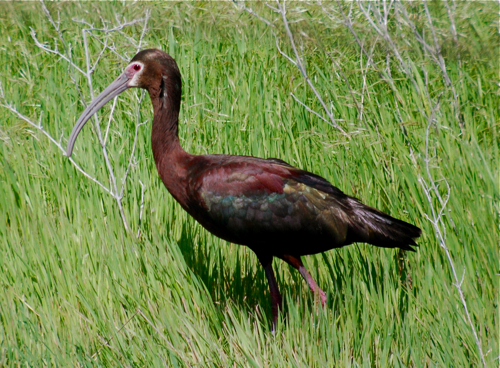
I'll leave you with a white-faced ibis foraging at Bear River Migratory Bird Refuge in Utah. This one did not get nailed by a peregrine falcon.
Homemade Heron Rookery
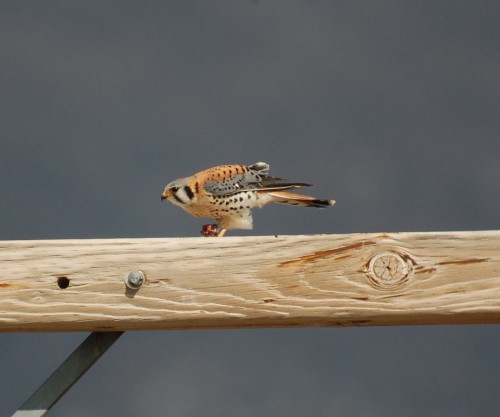
I love this little male kestrel snacking on a small rodent it plucked from a field in Utah. I got its photo at the same place I had my unexpected weasel encounter called Farmington Bay WMA.
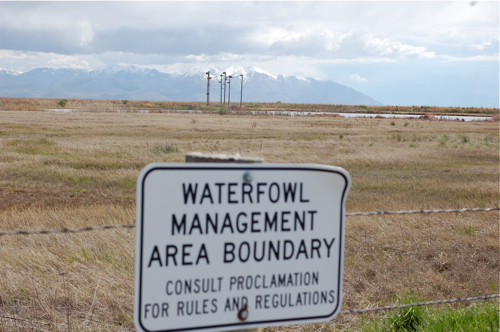
One of the coolest features about this wildlife management area is the homemade great blue heron rookery that is actually being used. I've seen plans for these in books like the fabulous Woodworking For Wildlife and I've seen a few erected, but never have I seen an artificial heron rookery being used by herons.
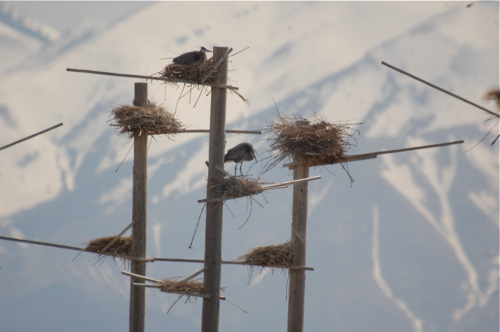 I'm used to seeing great blue heron rookeries on the Mississippi River surrounded by trees, not with a dramatic background full of snow capped mountains--too cool. Apparently, this heron nesting habitat was part of a boy scout project, that is one huge undertaking, but how sweet to see the kids' hard work pay off with actual birds.
I'm used to seeing great blue heron rookeries on the Mississippi River surrounded by trees, not with a dramatic background full of snow capped mountains--too cool. Apparently, this heron nesting habitat was part of a boy scout project, that is one huge undertaking, but how sweet to see the kids' hard work pay off with actual birds.
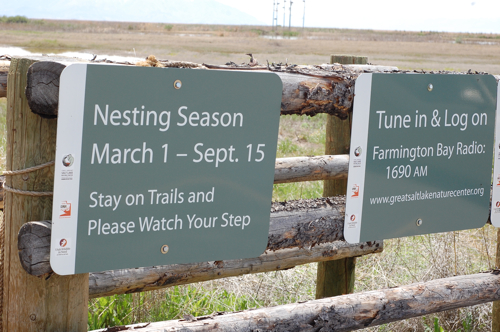 Farmington works hard to keep humans from tramping on ground nesting birds. Trails are blocked from motorized vehicle traffic during nesting season and signs warn you to watch your step.
Farmington works hard to keep humans from tramping on ground nesting birds. Trails are blocked from motorized vehicle traffic during nesting season and signs warn you to watch your step.
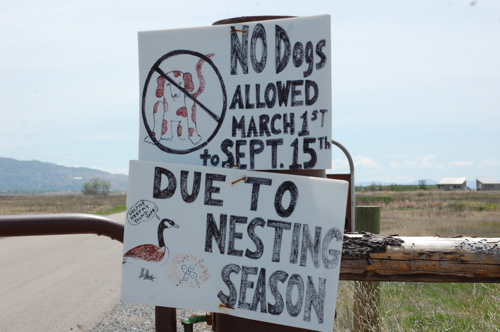
Even dogs are kept away to prevent altercations with waterfowl or to protect wayward chicks from becoming unintentional chew toys.
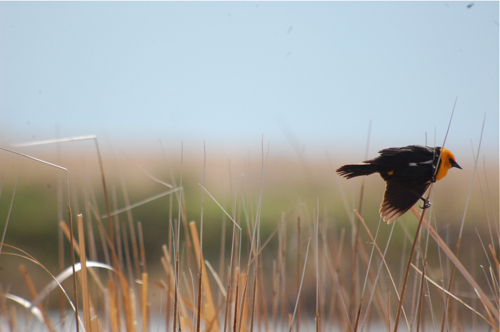
Utah is loaded with yellow-headed blackbirds and they are one of the common nesting birds at this site as are shorebirds. If you have limited time in Utah, this is worth a stop for western US specialties.
